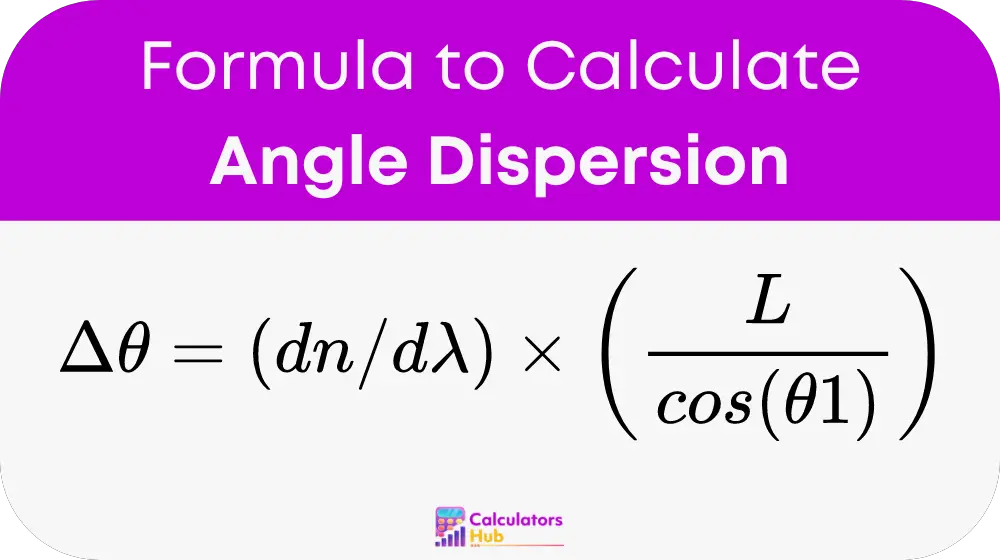The Angle Dispersion Calculator is a specialized tool utilized primarily in optics and photonics. It calculates the angular dispersion of light as it passes through different media, a phenomenon critical in designing optical devices like spectrometers and lasers. Understanding angular dispersion is essential for scientists and engineers working on applications ranging from telecommunications to medical imaging.
Formula of Angle Dispersion Calculator
The calculation of angular dispersion, denoted as Δθ, is based on the properties of the medium through which light travels, including its refractive index’s wavelength dependence:

Where:
- Δθ is the angular dispersion.
- dn/dλ is the derivative of the refractive index with respect to wavelength, indicating how the refractive index changes with wavelength.
- L is the length of the medium through which the light travels.
- θ1 is the angle of incidence.
Steps for Calculation:
- Identify the Refractive Index as a Function of Wavelength, n(λ).
- Calculate the Derivative of the Refractive Index with Respect to Wavelength, dn/dλ.
- Measure the Length of the Medium (L).
- Determine the Angle of Incidence (θ1).
- Convert the Angle of Incidence from Degrees to Radians if Necessary:
- Angle in Radians = Angle in Degrees * (π / 180)
- Calculate the Cosine of the Angle of Incidence:
- cos(θ1) = cos(Angle in Radians)
- Compute the Angular Dispersion Using the Formula:
- Δθ = (dn/dλ) * (L / cos(θ1))
Table of General Terms and Definitions
To assist users in understanding and applying the concepts related to angular dispersion, here’s a handy table:
| Term | Definition | Relevance |
|---|---|---|
| Angular Dispersion (Δθ) | The measure of the spread of light angles due to dispersion | Central to calculating prism and grating behavior |
| dn/dλ | Rate of change of refractive index with wavelength | Key to determining how light will spread in different materials |
| Length of Medium (L) | Distance light travels within the medium | Affects the extent of dispersion |
| Angle of Incidence (θ1) | Initial angle at which light strikes the medium | Impacts the direction and extent of dispersion |
Example of Angle Dispersion Calculator
Imagine a light beam passing through a glass prism with a length of 2 meters. Suppose the angle of incidence is 30 degrees and the dn/dλ for the glass at the specific wavelength is 0.01. The steps to find the angular dispersion would be:
- Convert the angle of incidence to radians:
- 30 degrees * (π / 180) ≈ 0.5236 radians.
- Calculate the cosine of the angle of incidence:
- cos(0.5236) ≈ 0.866.
- Calculate the angular dispersion:
- Δθ = 0.01 * (2 / 0.866) ≈ 0.0231 radians.
This example demonstrates how the Angle Dispersion Calculator is used to predict the behavior of light in optical systems, essential for precise scientific and engineering applications.
Most Common FAQs
Angular dispersion allows optical designers to predict and control how light behaves in instruments, leading to better performance in applications such as spectroscopy and fiber optics.
The longer the light travels through a dispersive medium, the greater the angular dispersion, which can lead to more significant separation of light into its component wavelengths.
Yes, the Angle Dispersion Calculator can be applied to any light, assuming the refractive index data for the specific wavelength and medium are known.